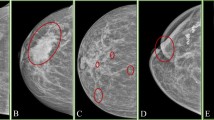Abstract
Microcalcifications are tiny deposits of calcium located in breast tissue. They appeared as very small highlighted regions in comparison with their surrounding tissue. Spatial non linear enhancement can be applied for microcalcification detection. However, efficiency of a such approach depends on breast density: in case of extreme breast density, the contrast between microcalcification’s details and their surrounding tissue is attenuated leading to a limitation of spatially based approaches. In that case, frequency analysis such as wavelet based analysis can be more relevant for dissociating microcalcifications. The main goal of Computer Aided Detection systems (CAD) is to detect breast cancer at an early stage for all breast density classes by using entropies to enhance and then detect microcalcification details. Accordingly, we combine our approach a spatial Automatic Non Linear Stretching (ANLS) and Shannon Entropy based Wavelet Coefficient Thresholding (SE_WCT). Validation of the proposed approach is done on the Mammographic Image Analysis Society (MIAS) database. The evaluation of the contrast is based on the Second-Derivative-Like measure of enhancement(SDME). Accordingly, it yields to a mean SDME of 78.8dB on the whole database. The performance metric for evaluating our proposed CAD is the Receiver Operating Characteristic(ROC) curve and the free-response ROC (FROC). An area under the ROC curve A z = 0.92 is obtained as well as 97.14 % of True Positives (TP) with 0,48 False positives per image (FP).








Similar content being viewed by others
References
Ayman AA (2015) Automatic microcalcification detection using wavelet transform. International Journal of Computer Theory and Engineering:40–45
Arnau O, Albert T, Xavier L, Meritxell T, Lidia T, Melcior S, Jordi F, Reyer Z (2012) Automatic microcalcification and cluster detection for digital and digitised mammograms. Knowledge-Based System:68–75
Batchelder KA, Tanenbaum AB, Albert S, Guimond L, Arneodo A, Khalil A, Kestener P (2014) Wavelet-based 3D reconstruction of microcalcification clusters from two mammographic views: new evidence that fractal tumors are malignant and euclidean tumors are benign. PLOS ONE:1–11
Balakumaran T, Ila V, Gowrishankar C (2012) Detection of microcalcification clusters using hessian matrix and foveal segmentation method on multiscale analysis in digital mammograms. Journal Digit Imaging:607–619
Guo J, Chen S, Ge K, Sun Z (2014) Study on microcalcification detetction using wavelet singularity. International Journal of Signal Processing, Image processing and Pattern Recognition:203– 212
Karen P, Yicong Z, Sos A, Hongwei J (2011) Nonlinear unsharp masking for mammogram enhancement. IEEE transaction on information technology in biomedicine:918–928
Liu X, Mei M, Liu J, Hu W (2015) Microcalcification detection in full-field digital mammograms with PFCM clustering and weighted SVM-based method. EURASIP Journal on Advances in Signal Processing:1–13
Mohanalin J, Kumar KP, Kumar N (2009) Tsallis entropy based contrast enhancement of microcalcification. International Conference on Signal Acquisition and Processing:3–7
Moradmand H, Setayeshi S, Karimian AR, Sirous M, Akbari MI (2012) Comparing the performance of image enhnacement methods to detect microcalcification clusters in digital mammography. Iranien Journal of Cancer Prevention:61–68
Mouna Z, Alima DA, Dorra MS (2014) A non linear stretching image enhancement technique for microcalcification detection. 1st International Conference on Advanced Technologies for Signal and Image Processing:193–197
Mouna ZM, Norhene BAG, Alima MD, Dorra MS (2014) A new Tsallis based automatic non linear enhancement of mammograms for microcalcifications segmentation in high density breast. First International conference on Image Processing. Applications and Systems (IPAS):1–5
Mallat SG (1989) A theory for multiresolution signal decomposition: The wavelet representation. IEEE transaction on Pattern Analysis and Machine Intelligence:647–693
Marcelo AD, Andre VA, Carolina MA, Maria JGC, Antonio FCI, Wagner CA (2015) Evaluating geodesic active contours in microcalcifications segmentation on mammograms. Computer Methods and Programs in Biomedicine:487–426
Mohanalin J, Beenamol Prem KK, Nirmal K (2010) A novel automatic microcalcification detection technique using Tsallis entropy and a type II fuzzy index. Computers and Mathematics with Applications:2426–2432
Otsu N (1979) A threshold Selection Method from gray level histograms. IEEE Transaction on Systems, Man, Cybernetics:62–66
Pizer SM, Johnston RE, Ericksen JP, Muller KE (1990) Contrast-Limited Adaptive histogram equalization :speed and effectiveness. IEEE Visualization in Biomedical Computing:721–755
Papadopoulos A, Fotiadis DI, Costaridou SL (2008) Improvement of microcalcification cluster detection in mammography utilizing image enhancement techniques. Computers in Biology and Medicine:337–345
Papadopoulos A, Fotiadis DI, Likas A (2005) Characterization of clustered microcalcifications in digitized mammograms using neural network and support vector machine. Artificial Intelligence in Medicine:141–150
Shannon C, Weaver w (1964) The mathematical theory of communication. University of Illinois Press, Urbana
The Mammographic Image Analysis Society: Mini Mammography Database (2008), http://peipa.essex.ac.uk/info/mias.html.Internationalworkshopondigitalmammography:212–218
Vivona L, Cascio D, Fauci F, Raso G (2014) Fuzzy technique for microcalcifications clustering in digital mammograms. BMC Med Imaging:1–18
Wavelet Toolbox: http://www.mathworks.com/products/wavelet/
Xu W, Xia S, Duan H (2006) A novel computer aided diagnosis system of th mammogram. Lecture Notes in Control and Information Sciences:639–644
Yu S, Guan L (2000) A CAD system for the automatic detection of clustered microcalcifications in digitized mammogram films. IEEE Transactions on Medical Imaging:115–126
Acknowledgements
The authors would like to thank DR. Abid Riadh, radiologist at El Farabi Imaging center, Sfax, Tunisia, and at the Faculty of Medicine of Sfax for his helpful discussions and advices.
Author information
Authors and Affiliations
Corresponding author
Rights and permissions
About this article
Cite this article
Mehdi, M.Z., Ben Ayed, N.G., Masmoudi, A.D. et al. An efficient microcalcifications detection based on dual spatial/spectral processing. Multimed Tools Appl 76, 13047–13065 (2017). https://doi.org/10.1007/s11042-016-3703-9
Received:
Revised:
Accepted:
Published:
Issue Date:
DOI: https://doi.org/10.1007/s11042-016-3703-9




